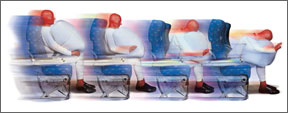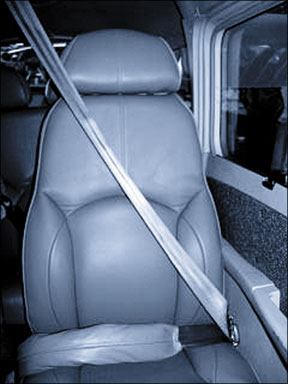Like ever
Finally, pilots and passengers have whats considered the ultimate equipment to improve crash survivability. AmSafe has been in business for over 30 years, getting its start in automotive restraint systems. In 1988, the aviation and auto industries concurrently drew up new passenger safety criteria. Prior to this, seatbelts had remained basically unchanged since the early 1950s. These early FAR Part 23 specs, which included approved materials and metal-to-metal buckles, protected passengers from face planting into their avionics through anything up to a 9G impact. With a new category of restraint requirements requiring protection up 26G essentially wide open, it gave companies the impetus to finally develop new technologies.
AmSafe had been building inertial reels for seatbelts and shoulder harnesses and began exploring the difficult task of getting an airbag between the passenger and anything hard in the cockpit. Clearly, the company couldnt follow the automotive paradigm of stuffing the airbag into the steering wheel or the passenger-side dashboard. Airplanes simply don’t have that usable real estate in front of the cabin occupants. The most practical way to deploy airbags in an airplane, AmSafe decided, was to put the airbag in the lap portion of a single-strap shoulder/lapbelt design.
Modern restraint systems in airplanes are usually a separate lapbelt and an across-the-chest single shoulder strap. Properly installed and worn, forward crash forces are kept linear and little damage is done to the back from compression forces. The direction of the mounting shoulder strap is pivotal in reducing injuries. The airlines had long been interested in a restraint system that would protect passengers seated just aft of bulkheads and other immovable objects in the cabin. With shoulder harnesses a non-starter for airline cabins, the only logical solution was an airbag large enough to create a short duration, pressurized but compressible buffer between head and hard.
Joe Smith, an AmSafe engineer, told us that the company realized that installing the airbag in either the shoulder portion of the belt or the lap belt was the most practical solution. In four-point designs such as the Cirrus, the bag goes on the shoulder belt. In three-point installations, as shown at right, the bag is on the lapbelt. For STC applications, this can use original mounting points.
The airbag-equipped belt is quite comfortable, although bulkier than a conventional lapbelt. The airbag is sewn into a leather strap that is, in essence, a combined shroud and cushion. It might get a bit warm on hot days, but in trying it out at the show demo sites, we found it acceptable.
On the bottom of the shoulder strap is a hose and fitting that attaches to a pack that mounts to the floor under the seat. This holds the compressed helium charge stored at 250 PSI and the accelerometer that activates deployment. AmSafe doesnt use a special stitch in the leather shroud since the charge is powerful enough to strip regular stitching.
The airbag is an emergency, one-time device and when its needed, the deployment is instantaneous. There are no provisions to repack and recharge the airbag, since the rest of the airplane will probably be past salvage anyway.
Different Sizes
There isn’t just one airbag, either. Smith told us that the bags are of different sizes and shapes and are optimized to the particular aircraft on which they are installed. The airbag volume can be anywhere from 20 to 25 cubic liters, which is typically the height and width of a standard torso. Theyre sized differently for rear seat installation.

Regarding seat location, AmSafe has developed airbags for passengers in business jets and the new VLJ aircraft where cabin occupants sit in seats facing the interior of the cabin, rather than forward or rearward, including Citations and Falcons. Additionally, they have developed a system for some of the seats in Virgin Atlantic jets that are on a 45-degree bias to centerline.
Cessna is installing front seat airbags in every new Cessna to roll off the line. To date, there are two instances of deployment where the airbags may have saved the lives of the pilot and co-pilots. There are other deployments, but these are under litigation and cannot be cited, according to AmSafe.
Unintended deployments are rare. There are 15 to 20 instances of aircraft running off the runway or hitting a ditch that did substantial damage to the aircraft but did not deploy the bags. One airbag was deployed when the seat was removed for maintenance and the assembly was dropped.

AmSafe is currently we’ll into a program for developing retrofit STCs for a number of models, including the Beechcraft line, Mooneys, the Legacy and Cessna 172 through 210s. This program is on a front burner, so retrofit kits should be available soon. Installation should be relatively easy because the OEM approval already exists. No insurmountable certification hurdles are expected.
As we mentioned in our article on seatbelts in the December 2006 issue, airbags arent cheap. AmSafe estimates that each seat will cost between $2000 and $2500 to equip. Are they worth it? In our view, this is strictly in the eye of the buyer. We think the airbags are still too new to be fairly judged, but airbags have performed we’ll in cars and based on AmSafes data thus far, they look promising for airplanes, too.





